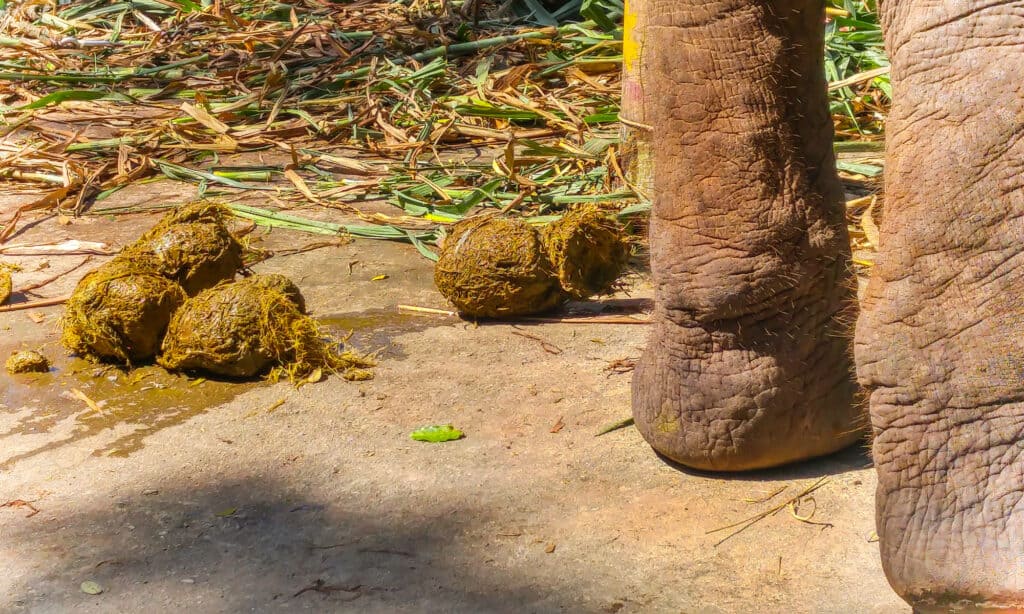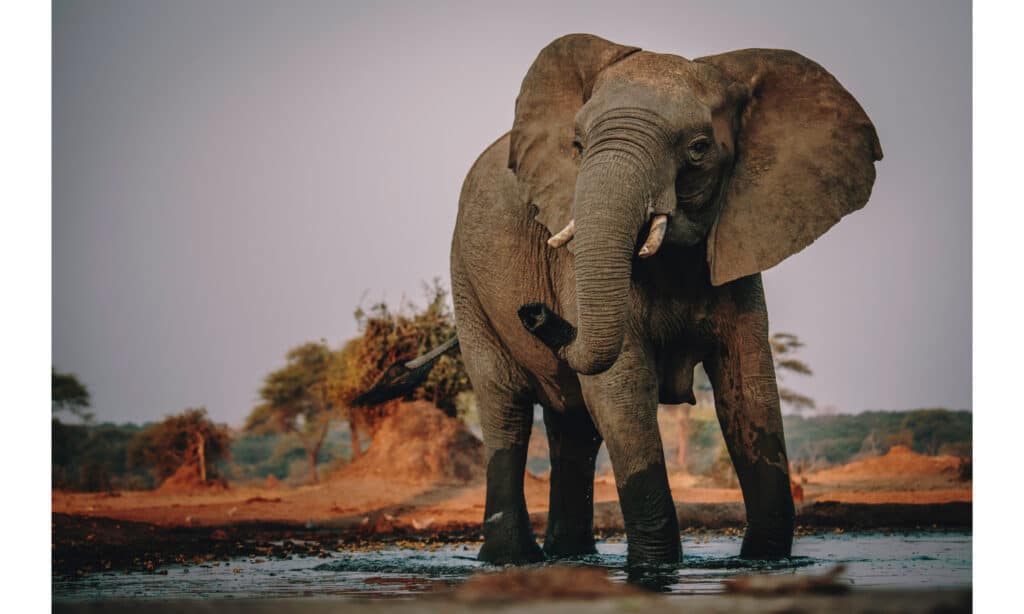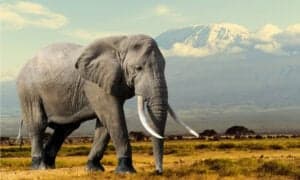When it comes to the topic of poop, elephant dung won’t usually come up. Why? Because elephant dung is not something you normally see on the street or on top of your cars like those of birds or raccoons! But did you know that elephant dung is one of the most used poop in the world? We know how chicken manure or bird poop can fertilize soils, bat guano also has its uses, and horse poop (surprisingly) can even be used as fuel. But when it comes to elephant dung, there is a long list of its uses in the environment.
Elephant dung is more than just animal waste or soil fertilizer. It can be utilized for so much more! The waste coming from elephants is generally called dung, and perhaps you don’t see them very often, but you already know they are way bigger than your dog or cat’s poop. So, what does elephant dung look like? Does it smell? Below, we will talk about everything you’ve ever wanted to know about elephant poop and more.
What Does an Elephant Dung Look Like?

On average, 220 pounds of dung can be produced daily by an adult elephant.
©MR.PRAWET THADTHIAM/Shutterstock.com
The world’s largest terrestrial mammal is the elephant; therefore, it is reasonable to expect that elephant dung would also be quite large.
African elephant dung is far less appealing than Asian elephant dung. Well-formed cannonballs of healthy Asian elephant excrement primarily comprise hay or grass. African elephant poop, on the other hand, is much looser and something you wouldn’t dare to pick up, and it resembles more of a cowpie. African elephants in captivity will throw it on themselves when they are hot, usually only when they are in the barn.
Elephants eat most of the day, and these gentle giants eat 330 to 440 lbs of food daily. So it isn’t surprising that up to 220 lbs (100 kg) of dung can be produced in a single day by an adult elephant on average. For a clear comparison, an average panda weighs as much! In Botswana, there are 130,000 elephants, which means that each day, they produce roughly 13,000 metric tons of excrement there! Therefore, it is not unexpected that, over time, people have come up with some fairly inventive uses for elephant excrement.
Does Elephant Dung Smell?

Elephant dung can be used as pain-relief medicine.
©Vassamon Anansukkasem/Shutterstock.com
Although voluminous, elephant dung gives off a less offensive smell. In fact, it smells somewhat nice, in the world of dung, of course. Unexpectedly, it also has a milder scent and is less irritating, which is why one of its functions is as an insect repellent. Its scent is even more pleasant and lighter to the nose than the typical spray-on repellent.
Another use of the elephant dung that proves its less offensive odor is as pain relief medicine. Elephant waste can even be taken as a painkiller. It is reported that simply breathing in the smoke from burning elephant dung will relieve toothaches, migraines, nose bleeds, and congested sinuses.
What is Elephant Dung Used For?

Elephant dung can also be converted into biodegradable paper.
©iStock.com/fotografie-kuhlmann
As mentioned above, elephant dung has a plethora of uses. This might surprise you, but elephant poop is more than just soil fertilizer. It can also be used as pain relief medication, emergency water, and mosquito repellent. Not impressed yet? How about this – elephant dung can also be converted into biodegradable paper! If that isn’t enough, elephant dung is also converted to renewable energy sources and even eccentric beer. And probably the most surprising among them, elephant dung can also be used to make coffee! Yes, you read that right, the most expensive coffee in the world actually comes from the elephant’s number 2. But before you frown and express your disgust, let’s discuss each of the elephant poop’s uses first and how and why they are used that way.
An elephant can create more than 40 tons of excrement in a single year, producing more than enough to aid many uses.
Elephant Biodegradable Paper
Elephant excrement is primarily made up of fiber because elephants only digest around half of their meal. That indicates that 55% of the food they eat is undamaged through their digestive system. When researchers discovered that up to 40% of elephant dung contains readily available cellulose, they concluded that it might be utilized to make paper. Elephant feces contains plant fiber that is ideal for manufacturing paper. The fibers are compressed into a pulp similar to that made from wood fibers, then used to create standard paper.
A typical elephant can make 115 sheets of paper per day that are different in texture from regular paper. However, as this prevents the destruction of neighboring forests or native trees and lowers overall deforestation, it is a small price to pay for the sustainability of the globe.
Mosquito Repellent
If burning horse poop makes fuel, then burning elephant poop can repel insects, especially mosquitos. People employ dangerous chemical sprays in many regions to keep mosquitos away. An all-natural, non-polluting substitute is elephant poo! It simply involves setting some dung on fire, and the smoke readily repels insects. Simply lighting a small amount of dried dung will produce a night-long mosquito-repelling cloud of smoke. You may worry that the odor will get worse. However, it actually has a musky, delightful scent that is less repulsive to the nose. In actuality, the commercial repellents smell far worse.
Black Ivory Coffee
Would you think that a pound of coffee beans found in elephant dung is worth $500? Elephants occasionally consume coffee beans, which undergo fermentation as they move through the animal’s digestive tract. A fruity, almost sweet flavor emerges, as a result, taking away the typical bitterness of coffee and leaving behind a chocolate-cherry flavor.
This may sound eerily similar to a Southeast Asian trend that was previously popular: cat coffee. The coffee beans can be broken down with the help of the civet cats’ digestive systems. Then someone makes your cup of coffee by brewing those beans. The fermentation process used by elephants to digest the cellulose in their food, in contrast to civets, brings out the sweet, fruity flavors of the coffee bean. Due to its softness on the palate, it has even been compared to a tea-coffee hybrid as all traces of bitterness disappear. It is known as Black Ivory Coffee and is only available in five-star resorts in Asia and the Middle East. Of course, before washing, drying, and roasting the beans, people must first remove them from the elephant poop.
Elephant Poop Beer
If coffee already sounds insane to you, then brace yourself for this one – elephant poop beer! The popularity of Black Ivory Coffee led to the creation of the even weirder Un Kono Kuro. The unusual drink’s name, “unko,” is a play on the Japanese term for “poo.” The same beans the elephants passed on are then fermented to make beer. The Sankt Gallen Brewery successfully produced beer from it for the first time. The byproduct beer has flavors that are comparable to those of coffee. With a little taste of chocolate, sweetness takes the place of bitterness. In fact, it was so successful that within minutes of its original release, all online beer supplies had been consumed.
Lifesaving Water
The initial thought of poop being used as consumable water sounds delusional, but for the elephant dung, it is indeed possible! Elephant dung is not typically used for this purpose, and you are not required to drink dung water unless it is an emergency. Nobody likes to find themselves in the predicament of having to squeeze the last drop of liquid from freshly dug elephant dung. However, if you ever find yourself stranded without water in a region where elephants prowl, this is a possible solution—although a fairly crude one. Elephant dung contains extremely few microorganisms, contrary to popular belief, and the advantages of consumption typically outweigh the risks.
Natural Pain Reliever
Elephants are herbivorous animals that consume a lot of fruits and vegetation, and traditional healers use the same fruits and foliage in natural treatments. A headache can be effectively treated by inhaling the dung smoke, lessening toothaches, and other ailments. Elephant dung smoke is also proven to relieve sinus and bleeding nose issues. So think about breathing in some elephant dung rather than exploring the savannah for the herb or bark used to treat a particular condition!
Renewable Energy Source
The need for renewable energy sources is rising. The time to develop alternatives is now, as fossil fuel supplies are running out, and the effects of global warming are being seen. Biogases made from animal manure are one of these solutions. Elephants, it turns out, are an excellent source of biogas. Due to their herbivorous diet and the vast quantities they defecate each day, this is the case. Their excrement can even produce energy, generating gas for burners, heat, and light.
Elephant feces is digested using biogas with methane and carbon dioxide as the byproducts of this process. These gaseous waste products are gathered by scientists and used to fuel stoves and gas engines.
The photo featured at the top of this post is © Volodymyr Burdiak/Shutterstock.com
Thank you for reading! Have some feedback for us? Contact the AZ Animals editorial team.






